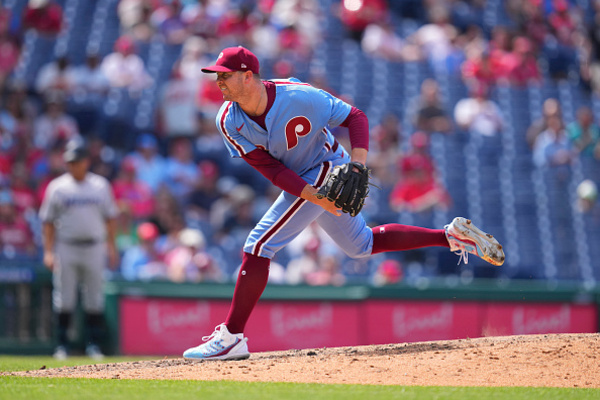



Corey Knebel of the Philadelphia Phillies throws a pitch against the Miami Marlins at Citizens Bank Park on August 11, 2022 in Philadelphia, Pennsylvania. The Marlins defeated the Phillies 3-0. (Photo by Mitchell Leff/Getty Images)
With the injury to Edwin Diaz’ patellar tendon suffered at the World Baseball Classic that will put the New York Mets closer on the shelf for the season following surgery, Steven A. Cohen’s team may have just reentered the market for quality relief pitching, one of baseball’s scarcest commodities.
Let’s take a look at three notable pitchers who remain available as opening day draws ever closer. Most are over the age of 30 and remain free agents for a reason: ineffectiveness, injury, or age. But as the season goes on, more teams will need pitching, and at least one of these pitchers will get a contract and a chance for another summer in the sun.
Zack Britton
Former New York Yankees closer Zack Britton, a lefty, worked out for several teams last week, and the New York Post’s Jon Heyman reported that the Mets were among 10 teams to send an observer. Britton has been hampered by injuries and has only thrown 19 innings in 25 appearances over the last two seasons, and the innings he threw were by no means stellar.
Coming off Tommy John surgery, Britton, 35, returned to mound on September 24 against Boston, entering the game in the top of the sixth and issuing a walk to Rafael Devers and giving up a single to Xander Bogaerts before striking out Alex Verdugo on three pitches. He then walked Enrique Hernandez and Triston Casas, allowing Devers to score, before he was yanked from the game.
Britton left his third appearance of 2022 with left arm soreness four days later. His three year, $39 million contract with the Yankees expired at the end of the season, making him a free agent.
Britton is by far the biggest name remaining on the market, but the big question is whether or not there’s anything left in his arm. He was effective the last time he was fully healthy during the Covid-19 Pandemic Shortened 2020 season, where he posted an ERA+* of 228 in 20 appearances. An organization will take a chance on him, as he can probably be signed to a minor league deal and start the season in Triple-A while he tries to regain form.
Archie Bradley
Bradley, a right hander, missed 123 days of his 2022 season with the Angels with an abdominal injury, an arm injury, and a broken elbow suffered after falling over the dugout railing in a rush to get to the field when a brawl broke out against the Seattle Mariners on June 26. His best season came in 2017 when he posted an ERA+ of 273 and a FIP** of 2.61 in 63 appearances (73.0 IP) with the Arizona Diamondbacks. In 2021, Bradley was serviceable, posting an ERA+ of 113 in 53 games with Philadelphia, which saw him throw 51 innings, striking out 40, with a WHIP*** of 1.431.
About 60% of Bradley’s pitches are four-seam fastballs, which he complements with a changeup, curveball, and sinker. If his elbow has healed from his bench clearing brawl misadventure, a team looking for a pitcher who can come out of the bullpen in the middle innings will likely see Bradley as an affordable option.
Corey Knebel
Knebel, 32, is a right hander who throws a four-seamer, a curveball, and a very occasional slider. He was steady, if unspectacular, in 46 games with the Philadelphia Phillies last year, posting an ERA+ of 119 and a WHIP of 1.366 in 44.2 innings pitched over 46 appearances before being shut down with a shoulder capsule injury.
The University of Texas alum has had something of an up-and-down career, mixing some sub-par years in between his best years. Knebel was an All-Star with the Milwaukee Brewers in 2017, a season that saw him appear in 76 games with a 248 ERA+ and a WHIP of 1.158 after a relatively ineffective season the year before.
He made $10 million on a one-year deal with the Phillies last year, but could probably be signed for much less, and if his shoulder is in good shape, he might be the best bargain out there.
–
*ERA+ – ERA+ normalizes a pitcher’s ERA by discounting the effect of his home ballpark and opponents. An ERA+ of 100 is exactly the league average, while a higher number indicates better performance.
**FIP – FIP, or Fielding Independent Pitching, measures a pitcher’s effectiveness based on strikeouts, unintentional walks, hit batsmen, and home runs – in other words, things solely within a pitcher’s control. It discounts the effects of having a good or bad fielding team behind, and is pegged to a constant that is equal to the league-average ERA. The lower the FIP number, the better the pitcher’s performance over the timespan measured.
***WHIP – WHIP, or Walks and Hits to Innings Pitched, measures a pitcher’s effectiveness in keeping runners from reaching base. The lower the number, the better.